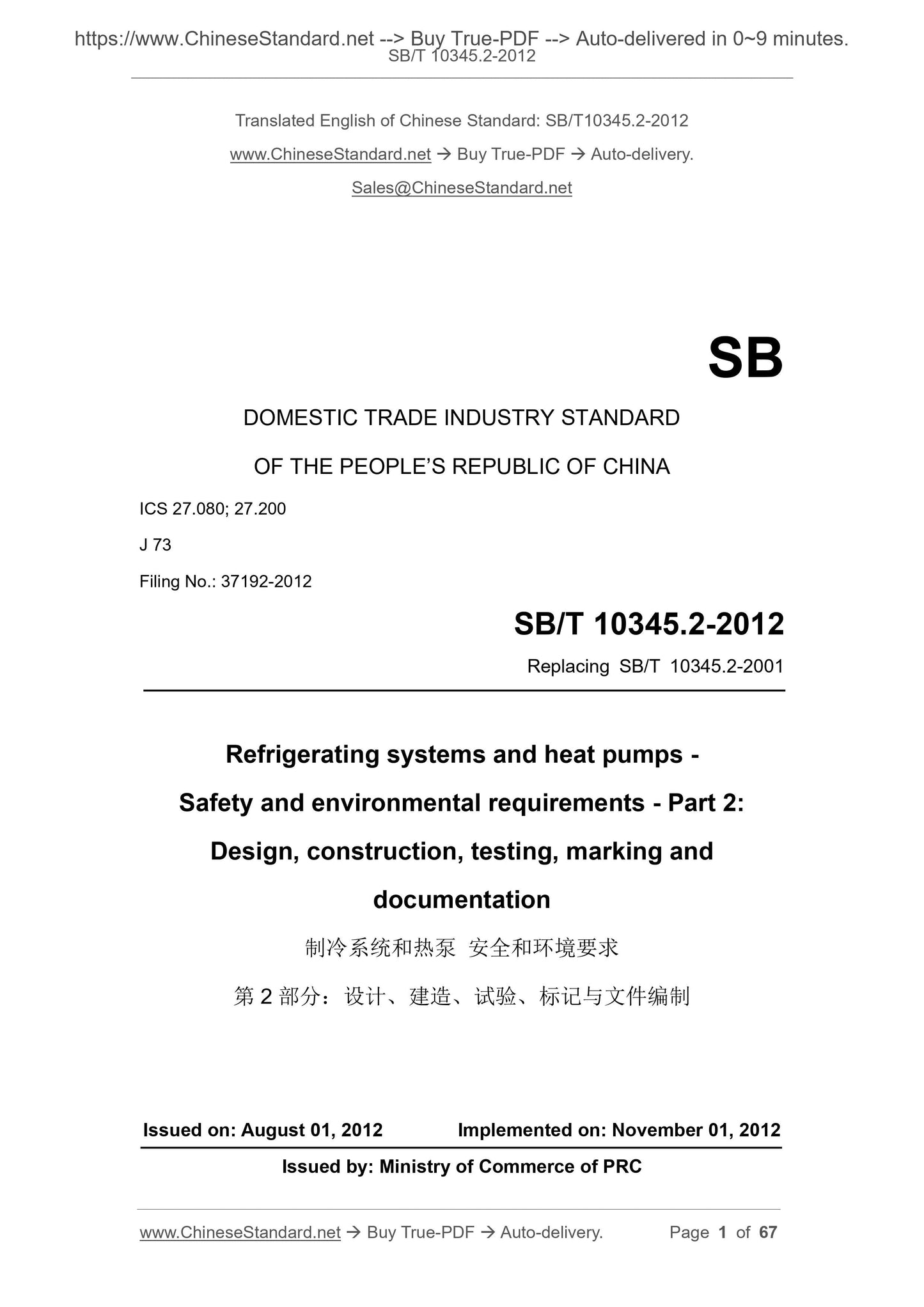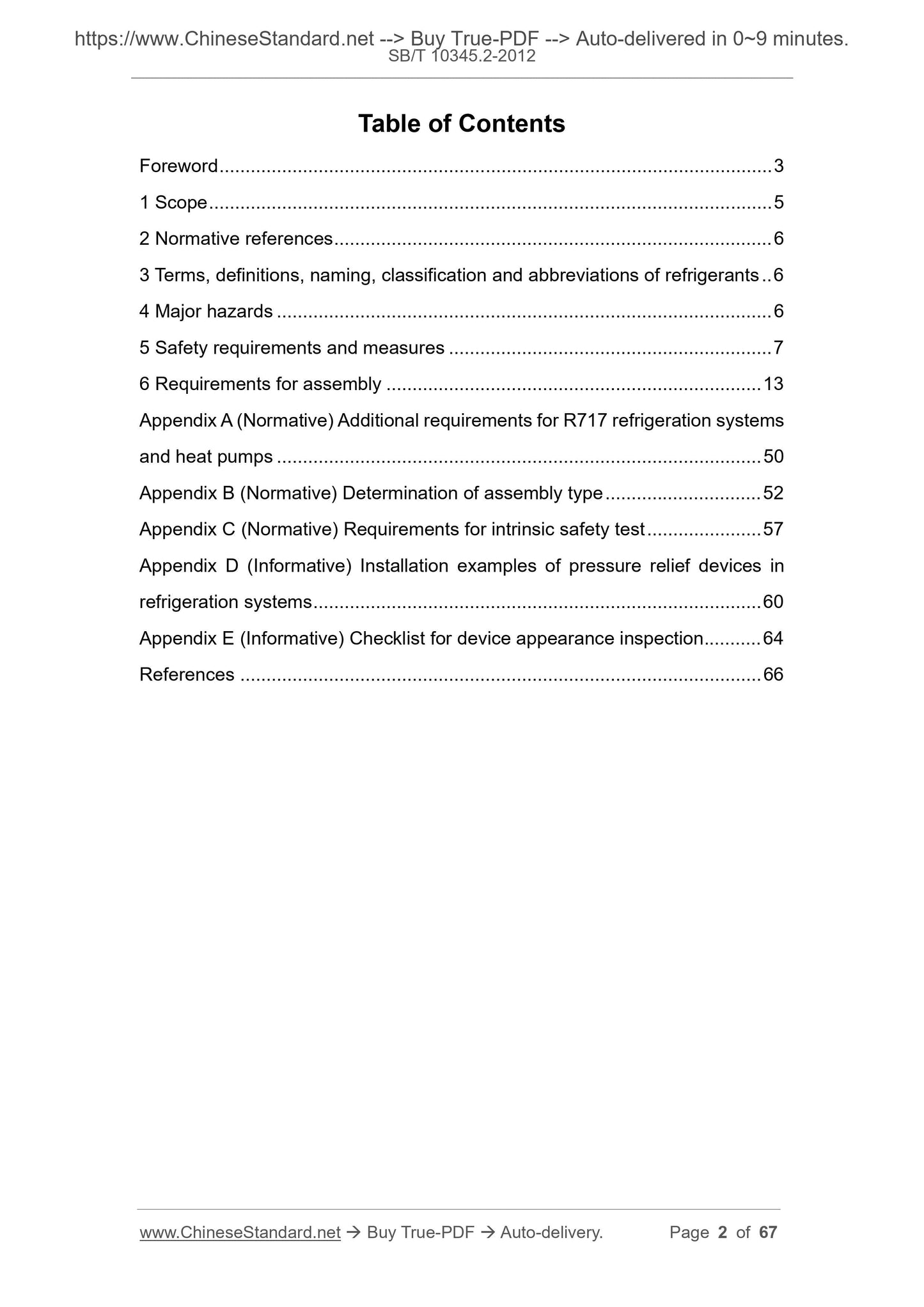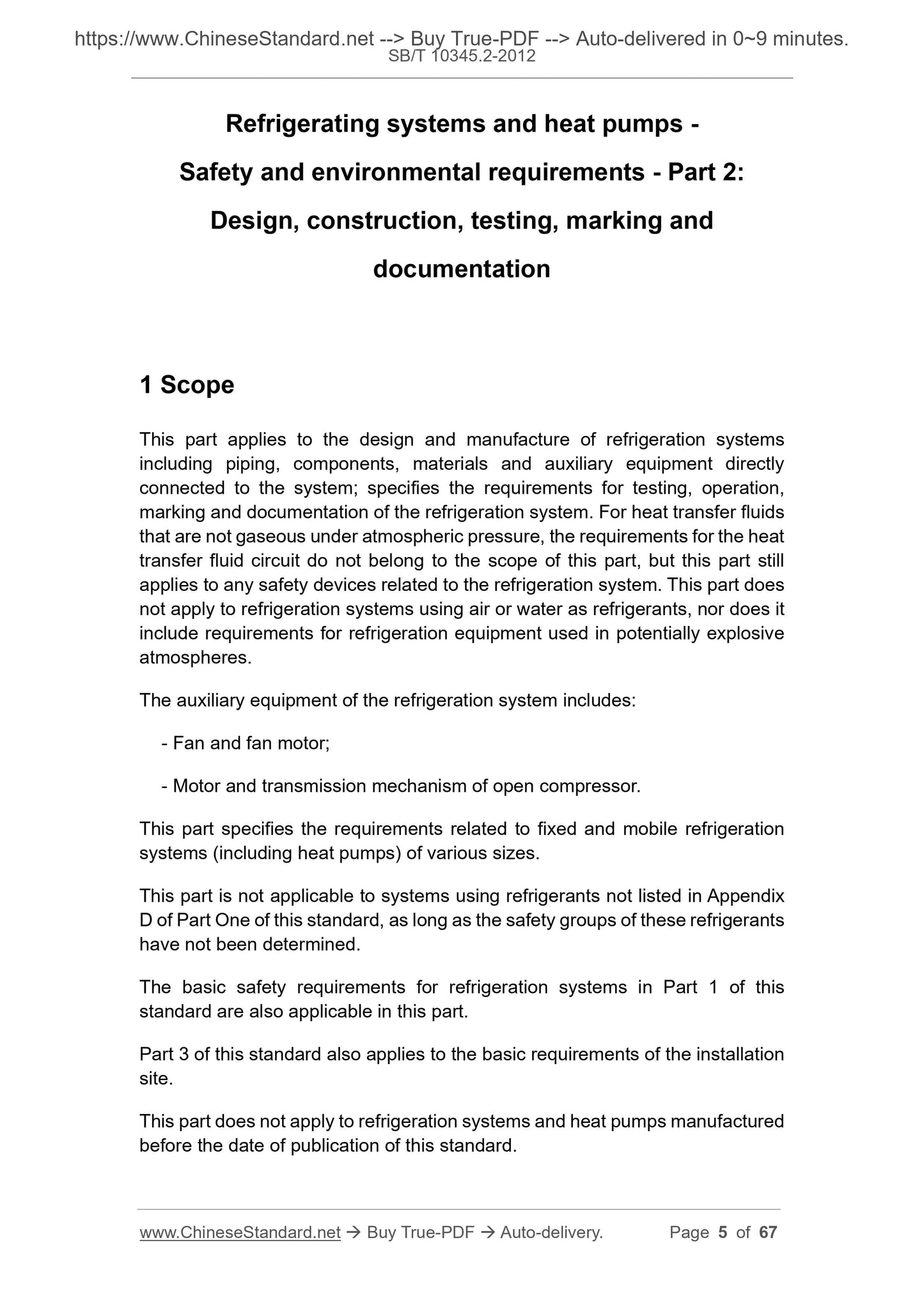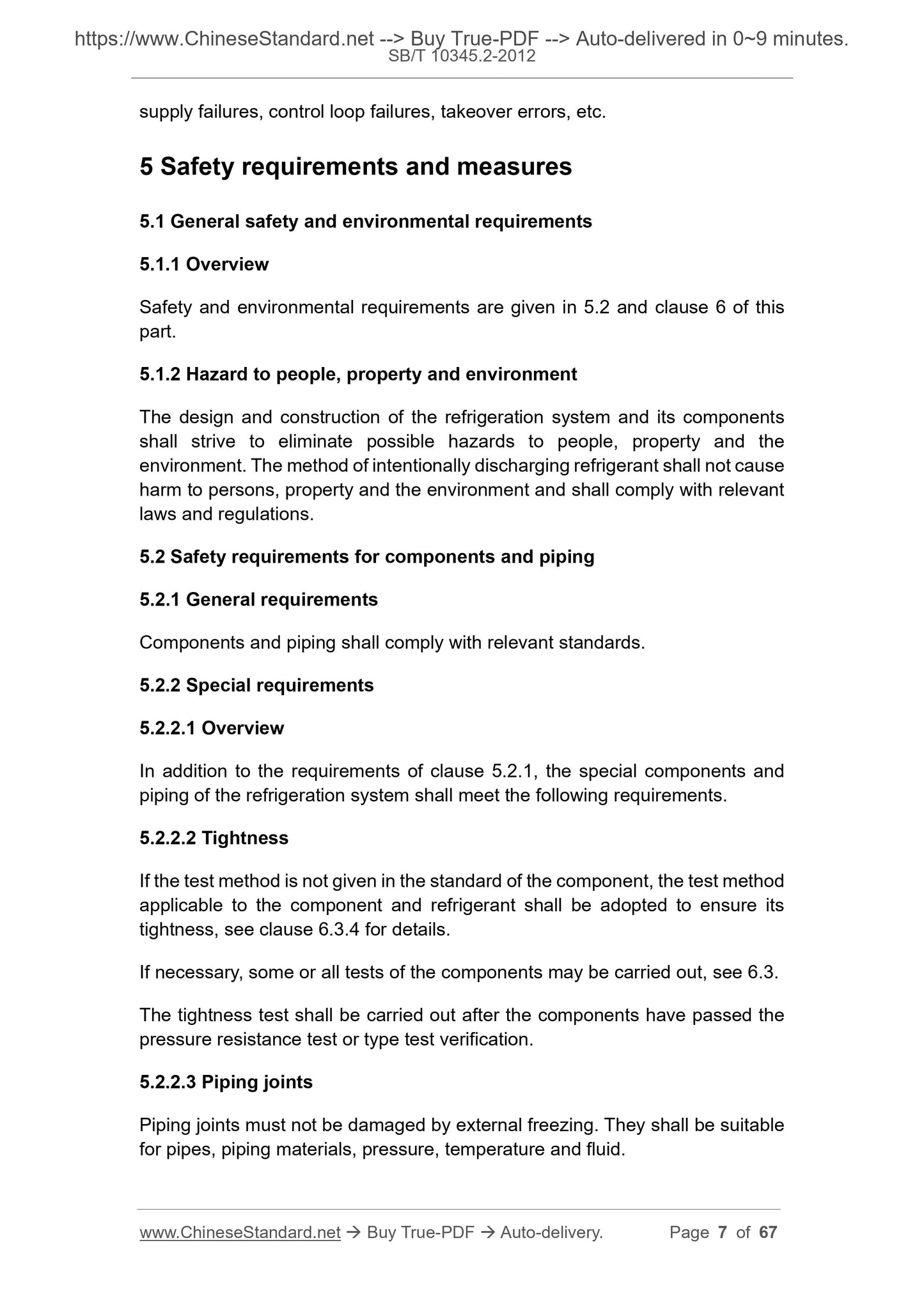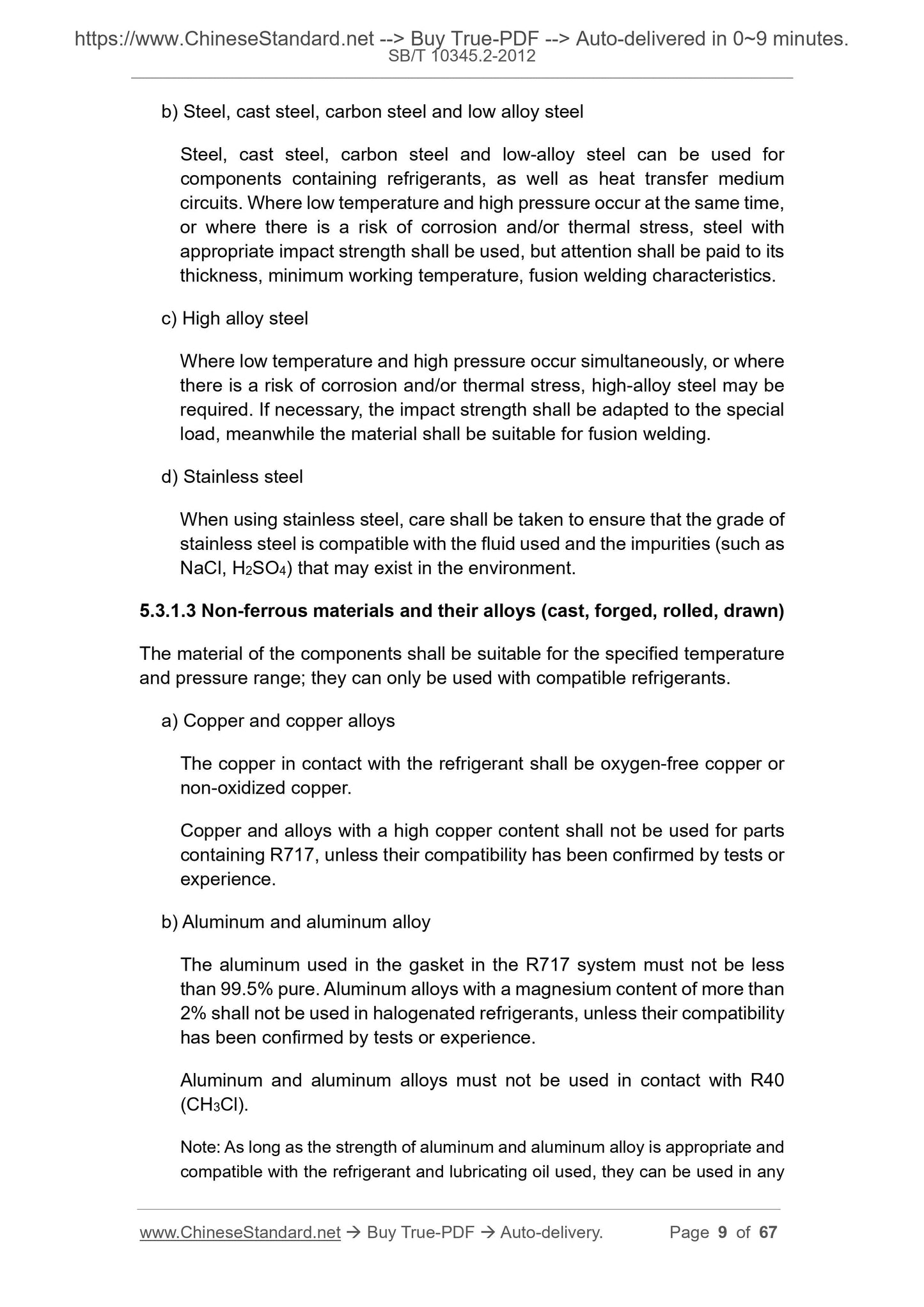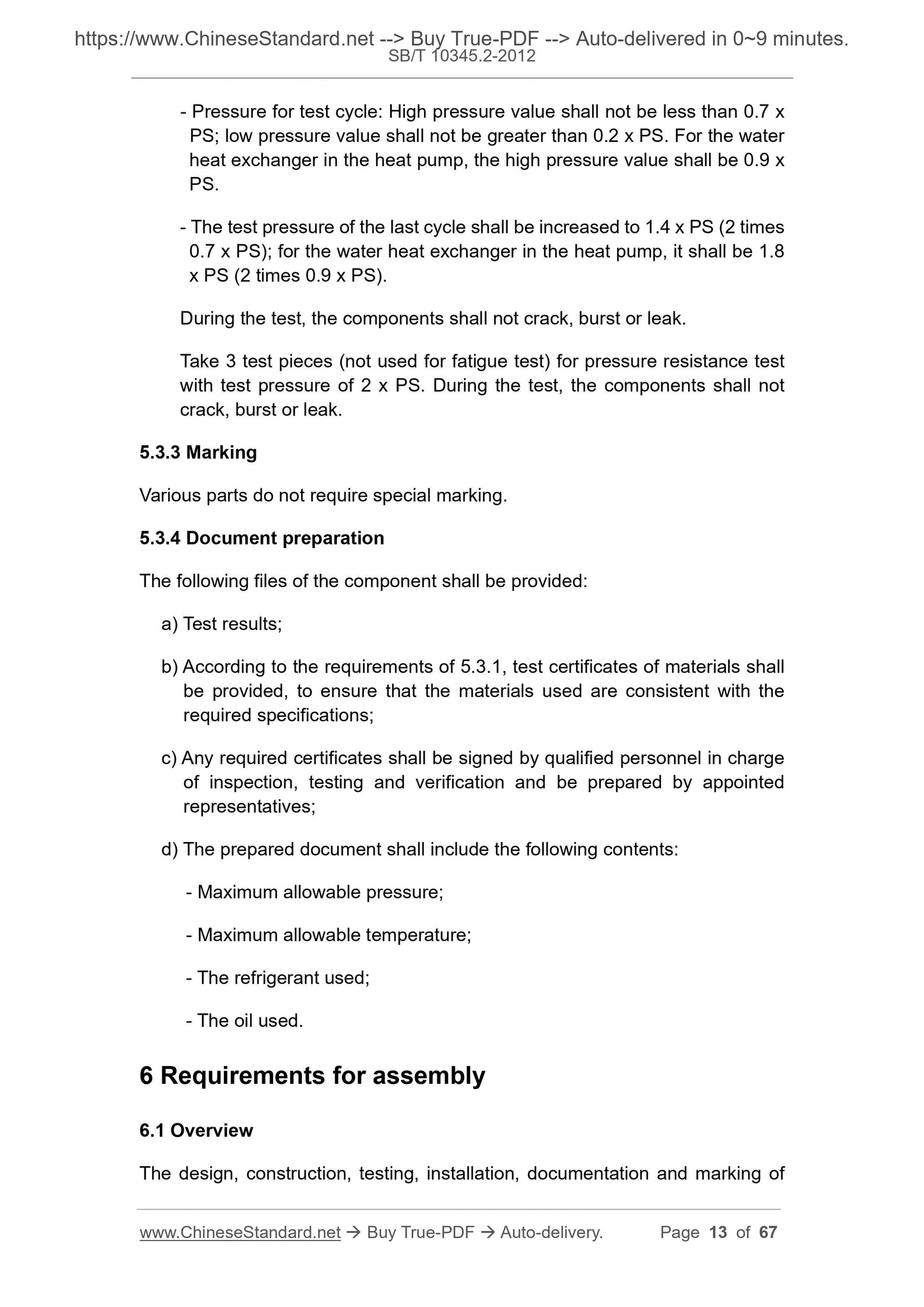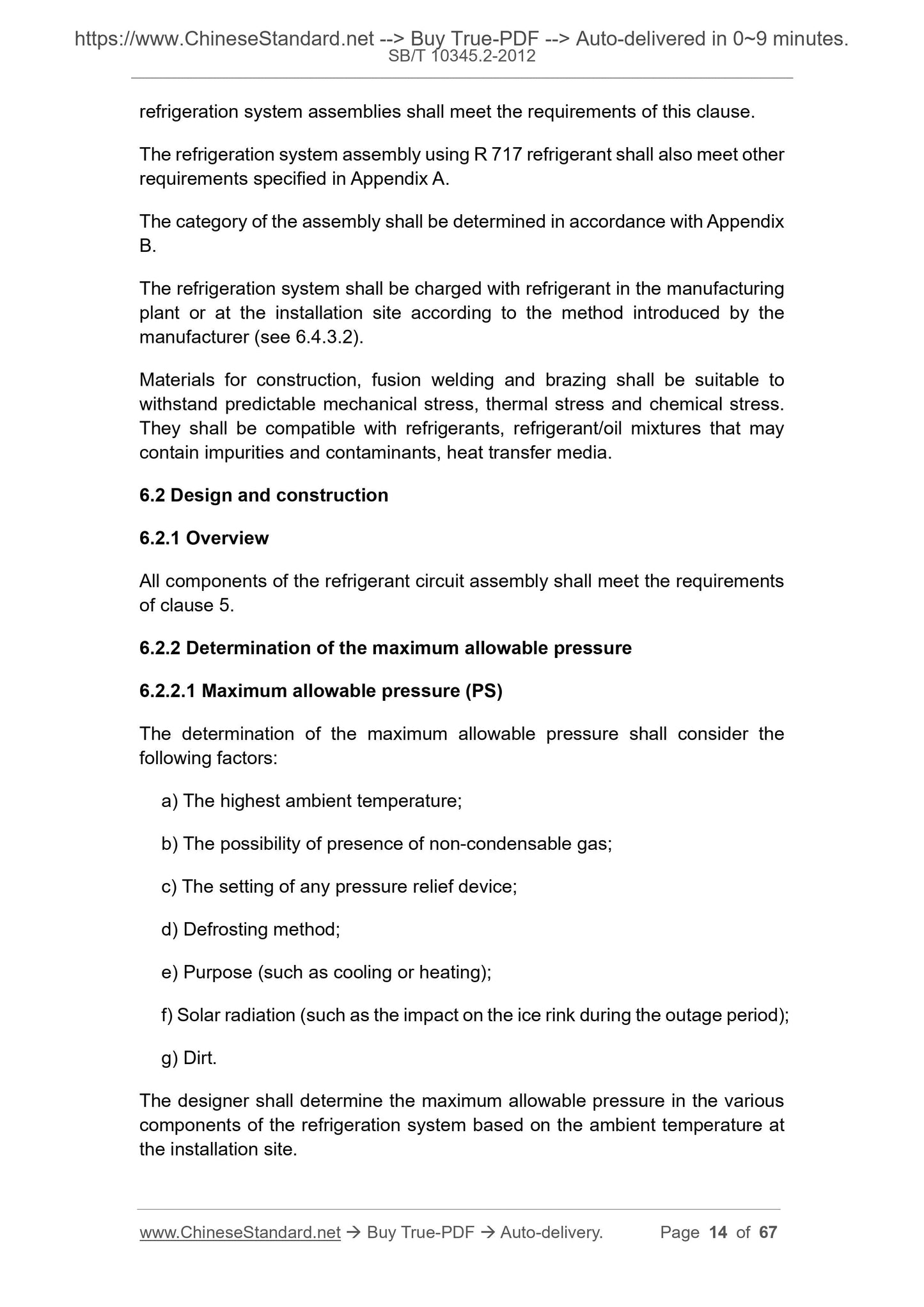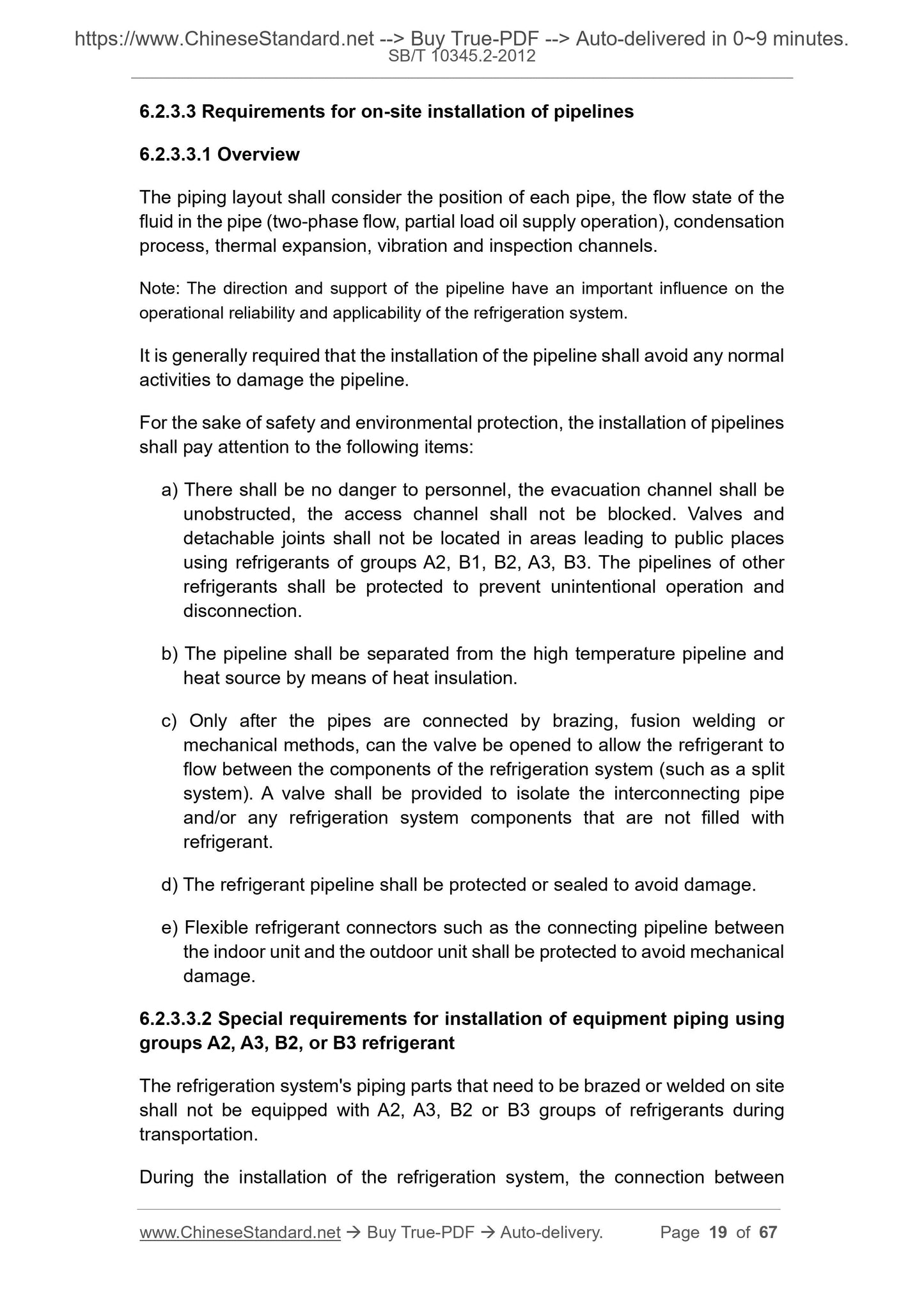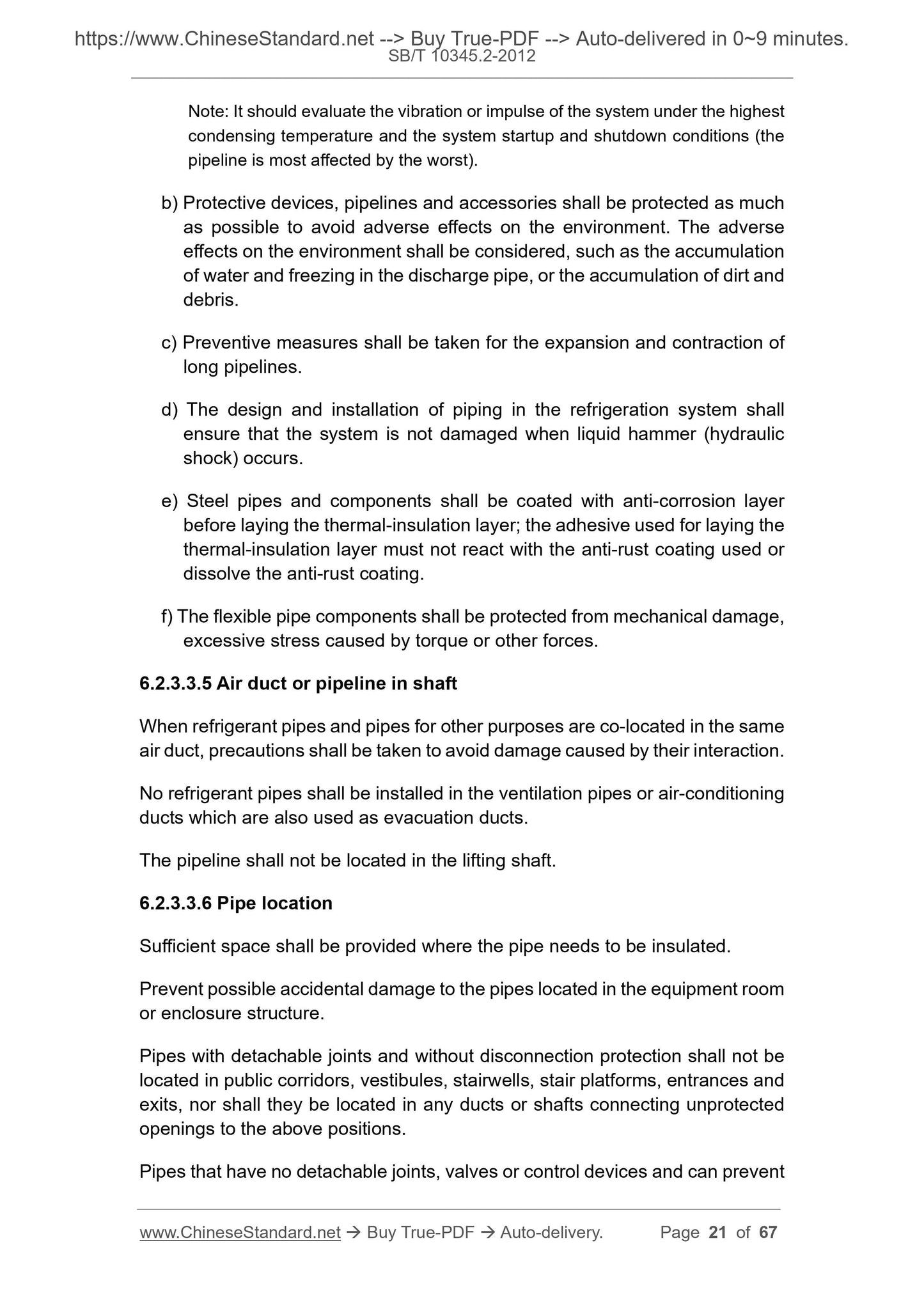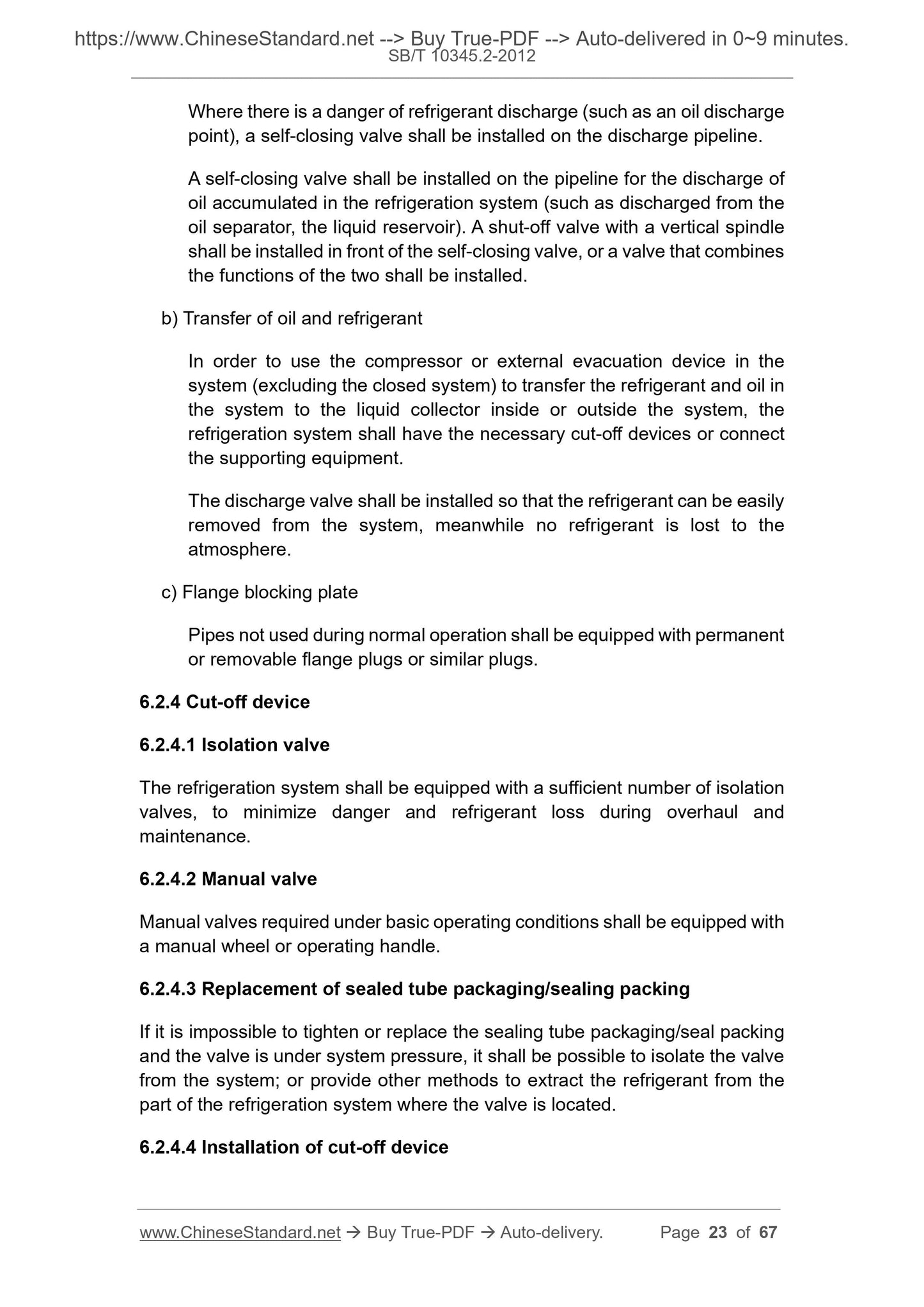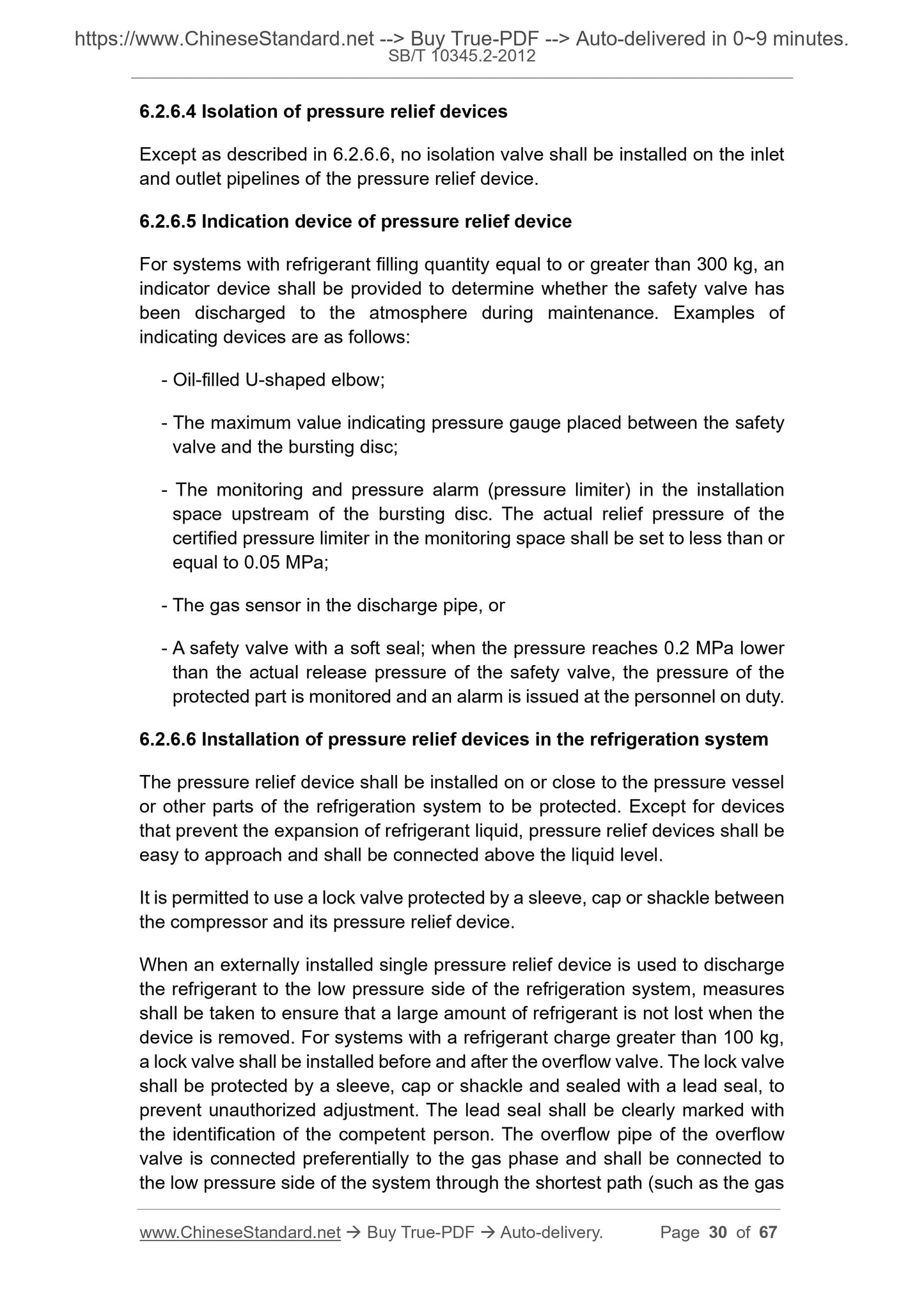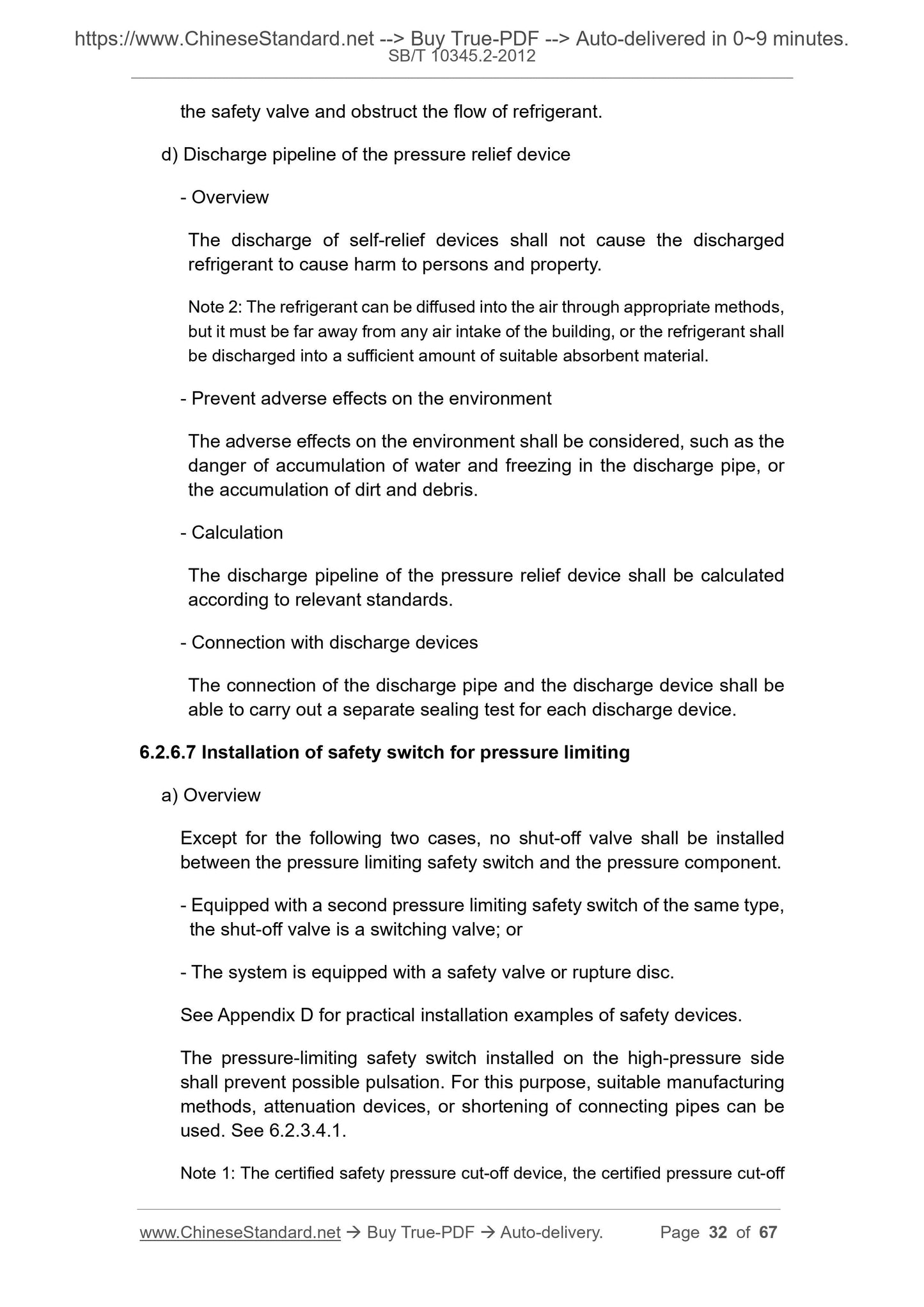1
/
of
12
PayPal, credit cards. Download editable-PDF and invoice in 1 second!
SB/T 10345.2-2012 English PDF (SB/T10345.2-2012)
SB/T 10345.2-2012 English PDF (SB/T10345.2-2012)
Regular price
$630.00 USD
Regular price
Sale price
$630.00 USD
Unit price
/
per
Shipping calculated at checkout.
Couldn't load pickup availability
Delivery: 3 seconds. Download true-PDF + Invoice.
Get QUOTATION in 1-minute: Click SB/T 10345.2-2012
Historical versions: SB/T 10345.2-2012
Preview True-PDF (Reload/Scroll if blank)
SB/T 10345.2-2012: Refrigerating systems and heat pumps. Safety and environmental requirements. Part 2: Design, construction, testing, marking and documentation
SB/T 10345.2-2012
SB
DOMESTIC TRADE INDUSTRY STANDARD
OF THE PEOPLE’S REPUBLIC OF CHINA
ICS 27.080; 27.200
J 73
Filing No.: 37192-2012
Replacing SB/T 10345.2-2001
Refrigerating systems and heat pumps -
Safety and environmental requirements - Part 2:
Design, construction, testing, marking and
documentation
ISSUED ON: AUGUST 01, 2012
IMPLEMENTED ON: NOVEMBER 01, 2012
Issued by: Ministry of Commerce of PRC
Table of Contents
Foreword ... 3
1 Scope ... 5
2 Normative references ... 6
3 Terms, definitions, naming, classification and abbreviations of refrigerants .. 6
4 Major hazards ... 6
5 Safety requirements and measures ... 7
6 Requirements for assembly ... 13
Appendix A (Normative) Additional requirements for R717 refrigeration systems
and heat pumps ... 50
Appendix B (Normative) Determination of assembly type ... 52
Appendix C (Normative) Requirements for intrinsic safety test ... 57
Appendix D (Informative) Installation examples of pressure relief devices in
refrigeration systems ... 60
Appendix E (Informative) Checklist for device appearance inspection ... 64
References ... 66
Refrigerating systems and heat pumps -
Safety and environmental requirements - Part 2:
Design, construction, testing, marking and
documentation
1 Scope
This part applies to the design and manufacture of refrigeration systems
including piping, components, materials and auxiliary equipment directly
connected to the system; specifies the requirements for testing, operation,
marking and documentation of the refrigeration system. For heat transfer fluids
that are not gaseous under atmospheric pressure, the requirements for the heat
transfer fluid circuit do not belong to the scope of this part, but this part still
applies to any safety devices related to the refrigeration system. This part does
not apply to refrigeration systems using air or water as refrigerants, nor does it
include requirements for refrigeration equipment used in potentially explosive
atmospheres.
The auxiliary equipment of the refrigeration system includes:
- Fan and fan motor;
- Motor and transmission mechanism of open compressor.
This part specifies the requirements related to fixed and mobile refrigeration
systems (including heat pumps) of various sizes.
This part is not applicable to systems using refrigerants not listed in Appendix
D of Part One of this standard, as long as the safety groups of these refrigerants
have not been determined.
The basic safety requirements for refrigeration systems in Part 1 of this
standard are also applicable in this part.
Part 3 of this standard also applies to the basic requirements of the installation
site.
This part does not apply to refrigeration systems and heat pumps manufactured
before the date of publication of this standard.
supply failures, control loop failures, takeover errors, etc.
5 Safety requirements and measures
5.1 General safety and environmental requirements
5.1.1 Overview
Safety and environmental requirements are given in 5.2 and clause 6 of this
part.
5.1.2 Hazard to people, property and environment
The design and construction of the refrigeration system and its components
shall strive to eliminate possible hazards to people, property and the
environment. The method of intentionally discharging refrigerant shall not cause
harm to persons, property and the environment and shall comply with relevant
laws and regulations.
5.2 Safety requirements for components and piping
5.2.1 General requirements
Components and piping shall comply with relevant standards.
5.2.2 Special requirements
5.2.2.1 Overview
In addition to the requirements of clause 5.2.1, the special components and
piping of the refrigeration system shall meet the following requirements.
5.2.2.2 Tightness
If the test method is not given in the standard of the component, the test method
applicable to the component and refrigerant shall be adopted to ensure its
tightness, see clause 6.3.4 for details.
If necessary, some or all tests of the components may be carried out, see 6.3.
The tightness test shall be carried out after the components have passed the
pressure resistance test or type test verification.
5.2.2.3 Piping joints
Piping joints must not be damaged by external freezing. They shall be suitable
for pipes, piping materials, pressure, temperature and fluid.
b) Steel, cast steel, carbon steel and low alloy steel
Steel, cast steel, carbon steel and low-alloy steel can be used for
components containing refrigerants, as well as heat transfer medium
circuits. Where low temperature and high pressure occur at the same time,
or where there is a risk of corrosion and/or thermal stress, steel with
appropriate impact strength shall be used, but attention shall be paid to its
thickness, minimum working temperature, fusion welding characteristics.
c) High alloy steel
Where low temperature and high pressure occur simultaneously, or where
there is a risk of corrosion and/or thermal stress, high-alloy steel may be
required. If necessary, the impact strength shall be adapted to the special
load, meanwhile the material shall be suitable for fusion welding.
d) Stainless steel
When using stainless steel, care shall be taken to ensure that the grade of
stainless steel is compatible with the fluid used and the impurities (such as
NaCl, H2SO4) that may exist in the environment.
5.3.1.3 Non-ferrous materials and their alloys (cast, forged, rolled, drawn)
The material of the components shall be suitable for the specified temperature
and pressure range; they can only be used with compatible refrigerants.
a) Copper and copper alloys
The copper in contact with the refrigerant shall be oxygen-free copper or
non-oxidized copper.
Copper and alloys with a high copper content shall not be used for parts
containing R717, unless their compatibility has been confirmed by tests or
experience.
b) Aluminum and aluminum alloy
The aluminum used in the gasket in the R717 system must not be less
than 99.5% pure. Aluminum alloys with a magnesium content of more than
2% shall not be used in halogenated refrigerants, unless their compatibility
has been confirmed by tests or experience.
Aluminum and aluminum alloys must not be used in contact with R40
(CH3Cl).
Note: As long as the strength of aluminum and aluminum alloy is appropriate and
compatible with the refrigerant and lubricating oil used, they can be used in any
- Pressure for test cycle: High pressure value shall not be less than 0.7 x
PS; low pressure value shall not be greater than 0.2 x PS. For the water
heat exchanger in the heat pump, the high pressure value shall be 0.9 x
PS.
- The test pressure of the last cycle shall be increased to 1.4 x PS (2 times
0.7 x PS); for the water heat exchanger in the heat pump, it shall be 1.8
x PS (2 times 0.9 x PS).
During the test, the components shall not crack, burst or leak.
Take 3 test pieces (not used for fatigue test) for pressure resistance test
with test pressure of 2 x PS. During the test, the components shall not
crack, burst or leak.
5.3.3 Marking
Various parts do not require special marking.
5.3.4 Document preparation
The following files of the component shall be provided:
a) Test results;
b) According to the requirements of 5.3.1, test certificates of materials shall
be provided, to ensure that the materials used are consistent...
Get QUOTATION in 1-minute: Click SB/T 10345.2-2012
Historical versions: SB/T 10345.2-2012
Preview True-PDF (Reload/Scroll if blank)
SB/T 10345.2-2012: Refrigerating systems and heat pumps. Safety and environmental requirements. Part 2: Design, construction, testing, marking and documentation
SB/T 10345.2-2012
SB
DOMESTIC TRADE INDUSTRY STANDARD
OF THE PEOPLE’S REPUBLIC OF CHINA
ICS 27.080; 27.200
J 73
Filing No.: 37192-2012
Replacing SB/T 10345.2-2001
Refrigerating systems and heat pumps -
Safety and environmental requirements - Part 2:
Design, construction, testing, marking and
documentation
ISSUED ON: AUGUST 01, 2012
IMPLEMENTED ON: NOVEMBER 01, 2012
Issued by: Ministry of Commerce of PRC
Table of Contents
Foreword ... 3
1 Scope ... 5
2 Normative references ... 6
3 Terms, definitions, naming, classification and abbreviations of refrigerants .. 6
4 Major hazards ... 6
5 Safety requirements and measures ... 7
6 Requirements for assembly ... 13
Appendix A (Normative) Additional requirements for R717 refrigeration systems
and heat pumps ... 50
Appendix B (Normative) Determination of assembly type ... 52
Appendix C (Normative) Requirements for intrinsic safety test ... 57
Appendix D (Informative) Installation examples of pressure relief devices in
refrigeration systems ... 60
Appendix E (Informative) Checklist for device appearance inspection ... 64
References ... 66
Refrigerating systems and heat pumps -
Safety and environmental requirements - Part 2:
Design, construction, testing, marking and
documentation
1 Scope
This part applies to the design and manufacture of refrigeration systems
including piping, components, materials and auxiliary equipment directly
connected to the system; specifies the requirements for testing, operation,
marking and documentation of the refrigeration system. For heat transfer fluids
that are not gaseous under atmospheric pressure, the requirements for the heat
transfer fluid circuit do not belong to the scope of this part, but this part still
applies to any safety devices related to the refrigeration system. This part does
not apply to refrigeration systems using air or water as refrigerants, nor does it
include requirements for refrigeration equipment used in potentially explosive
atmospheres.
The auxiliary equipment of the refrigeration system includes:
- Fan and fan motor;
- Motor and transmission mechanism of open compressor.
This part specifies the requirements related to fixed and mobile refrigeration
systems (including heat pumps) of various sizes.
This part is not applicable to systems using refrigerants not listed in Appendix
D of Part One of this standard, as long as the safety groups of these refrigerants
have not been determined.
The basic safety requirements for refrigeration systems in Part 1 of this
standard are also applicable in this part.
Part 3 of this standard also applies to the basic requirements of the installation
site.
This part does not apply to refrigeration systems and heat pumps manufactured
before the date of publication of this standard.
supply failures, control loop failures, takeover errors, etc.
5 Safety requirements and measures
5.1 General safety and environmental requirements
5.1.1 Overview
Safety and environmental requirements are given in 5.2 and clause 6 of this
part.
5.1.2 Hazard to people, property and environment
The design and construction of the refrigeration system and its components
shall strive to eliminate possible hazards to people, property and the
environment. The method of intentionally discharging refrigerant shall not cause
harm to persons, property and the environment and shall comply with relevant
laws and regulations.
5.2 Safety requirements for components and piping
5.2.1 General requirements
Components and piping shall comply with relevant standards.
5.2.2 Special requirements
5.2.2.1 Overview
In addition to the requirements of clause 5.2.1, the special components and
piping of the refrigeration system shall meet the following requirements.
5.2.2.2 Tightness
If the test method is not given in the standard of the component, the test method
applicable to the component and refrigerant shall be adopted to ensure its
tightness, see clause 6.3.4 for details.
If necessary, some or all tests of the components may be carried out, see 6.3.
The tightness test shall be carried out after the components have passed the
pressure resistance test or type test verification.
5.2.2.3 Piping joints
Piping joints must not be damaged by external freezing. They shall be suitable
for pipes, piping materials, pressure, temperature and fluid.
b) Steel, cast steel, carbon steel and low alloy steel
Steel, cast steel, carbon steel and low-alloy steel can be used for
components containing refrigerants, as well as heat transfer medium
circuits. Where low temperature and high pressure occur at the same time,
or where there is a risk of corrosion and/or thermal stress, steel with
appropriate impact strength shall be used, but attention shall be paid to its
thickness, minimum working temperature, fusion welding characteristics.
c) High alloy steel
Where low temperature and high pressure occur simultaneously, or where
there is a risk of corrosion and/or thermal stress, high-alloy steel may be
required. If necessary, the impact strength shall be adapted to the special
load, meanwhile the material shall be suitable for fusion welding.
d) Stainless steel
When using stainless steel, care shall be taken to ensure that the grade of
stainless steel is compatible with the fluid used and the impurities (such as
NaCl, H2SO4) that may exist in the environment.
5.3.1.3 Non-ferrous materials and their alloys (cast, forged, rolled, drawn)
The material of the components shall be suitable for the specified temperature
and pressure range; they can only be used with compatible refrigerants.
a) Copper and copper alloys
The copper in contact with the refrigerant shall be oxygen-free copper or
non-oxidized copper.
Copper and alloys with a high copper content shall not be used for parts
containing R717, unless their compatibility has been confirmed by tests or
experience.
b) Aluminum and aluminum alloy
The aluminum used in the gasket in the R717 system must not be less
than 99.5% pure. Aluminum alloys with a magnesium content of more than
2% shall not be used in halogenated refrigerants, unless their compatibility
has been confirmed by tests or experience.
Aluminum and aluminum alloys must not be used in contact with R40
(CH3Cl).
Note: As long as the strength of aluminum and aluminum alloy is appropriate and
compatible with the refrigerant and lubricating oil used, they can be used in any
- Pressure for test cycle: High pressure value shall not be less than 0.7 x
PS; low pressure value shall not be greater than 0.2 x PS. For the water
heat exchanger in the heat pump, the high pressure value shall be 0.9 x
PS.
- The test pressure of the last cycle shall be increased to 1.4 x PS (2 times
0.7 x PS); for the water heat exchanger in the heat pump, it shall be 1.8
x PS (2 times 0.9 x PS).
During the test, the components shall not crack, burst or leak.
Take 3 test pieces (not used for fatigue test) for pressure resistance test
with test pressure of 2 x PS. During the test, the components shall not
crack, burst or leak.
5.3.3 Marking
Various parts do not require special marking.
5.3.4 Document preparation
The following files of the component shall be provided:
a) Test results;
b) According to the requirements of 5.3.1, test certificates of materials shall
be provided, to ensure that the materials used are consistent...
Share
